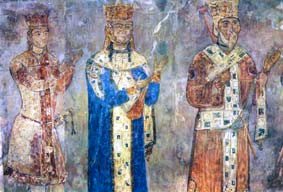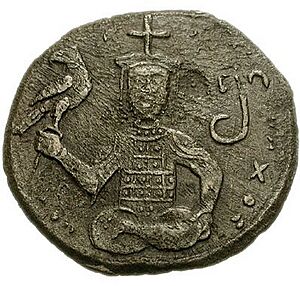George III of Georgia facts for kids
Quick facts for kids George IIIგიორგი III |
|
|---|---|

George III as depicted on a medieval fresco from Vardzia
|
|
| King of Georgia (more...) | |
| Reign | 1156–1184 |
| Predecessor | Demetrius I |
| Successor | Tamar |
| Died | 27 March 1184 |
| Burial | Gelati Monastery |
| Spouse | Burdukhan of Alania |
| Issue | Tamar of Georgia Rusudan |
| Dynasty | Bagrationi |
| Father | Demetrius I of Georgia |
| Religion | Georgian Orthodox Church |
| Khelrtva | |
George III (Georgian: გიორგი III, romanized: giorgi III) was a powerful king of Georgia. He belonged to the Bagrationi dynasty. George III ruled from 1156 to 1184. He became king after his father, Demetrius I, passed away. His time as king was part of Georgia's "Georgian Golden Age." This was a special period when Georgia was very strong. It was also a time of great growth and development.
Contents
Life as King: George III's Reign
George III became king in 1156. He changed his father's way of ruling. Instead of just defending, he became more active. He started campaigns against the neighboring Seljuqid rulers. These rulers were in Armenia.
Battles and Victories
In 1156, George launched a successful campaign. He fought against the Shah-Armens. These rulers had often fought against Georgia. They even helped Georgian nobles who were unhappy with their own kings.
In 1156, the Christian people of Ani rose up. Ani was a town ruled by Fakr al-Din Shaddad ibn Mahmud. He was a ruler who served George III. The people gave the town to Fakr al-Din's brother. But this brother also failed to please them. So, the town was offered to King George III. He took control of Ani. In 1161, he made his general, Ivane Orbeli, its new ruler.
Other rulers formed a group against Georgia. This group included the Shah-Armen Sökmen II. It also had rulers from Diyarbekir and Erzerum. But George III defeated them all. He then marched against the king of Erzerum. In 1161, he captured this king. George III later released him for a large payment.
Taking Ani and defeating the Saltukid forces helped George III. It allowed him to march on Dvin. In 1162, Dvin was taken for a short time. The city was looted, and Georgian troops returned with treasures. The king appointed a local noble, Ananiya, to govern Dvin.
Challenges and Peace
In 1163, a group of Muslim rulers attacked Georgia. This group was led by Ildeniz. He was a powerful ruler from Adarbadagan. The Shah-Armen Sökmen II also joined him. Their army had 50,000 soldiers. They marched into Georgia. The Georgian army was defeated. The enemy took the fortress of Gagi. They also damaged the regions of Gagi and Gegharkunik. They took prisoners and valuable items.
However, George III acted quickly. In 1166, he marched into Arran. He took control of an area near Ganja. He damaged the land and returned with prisoners and goods. In 1167, George III helped his ally, Shah Aghsartan of Shirvan. He defended him against attacks from the Khazar and Kipchak people. This helped Georgia keep its strong position in the area.
The fighting between George III and atabeg Eldiguz seemed endless. But both sides grew tired. Eldiguz suggested a truce. George agreed to make peace. He gave Ani back to its former rulers, the Shaddadids. They became his allies. The Shaddadids ruled Ani for about 10 years. But in 1174, King George took Shahanshah ibn Mahmud prisoner. He took Ani back again. Ivane Orbeli was again made governor of the town. During this time, many Armenian volunteers joined the Georgian army. They were eager to help free their country.
Dealing with Rebellions and Succession
In 1177, George III faced a rebellion. Some nobles wanted to remove him from the throne. They wanted to replace him with his nephew, Demna. These nobles were led by Ivane Orbeli. Their real goal was to weaken the king's power. George III managed to stop the rebellion. He punished the nobles who had defied him. Ivane Orbeli was put to death. His family members who survived were forced to leave Georgia. Demna later died in prison.
After the rebellion, George III made an important decision. He made his daughter, Tamar, a co-ruler in 1178. He crowned her as queen alongside him. By doing this, he wanted to prevent any arguments about who would rule after him. He also wanted to make sure his family line would continue on the Georgian throne. At the same time, he brought new people into power. These were from the Kipchaks and other groups. This helped to keep the powerful noble families from having too much control.
George III passed away on March 27, 1184. His daughter, Tamar, became the next ruler. He was buried at Gelati Monastery in western Georgia.
Family Life: Marriage and Children

Around 1155, King George III married Burdukhan. She was the daughter of the King of Alania. They had two daughters:
- Tamar: She became queen after her father.
- Rusudan: She married Manuel Komnenos. Manuel was the son of Andronikos I, who was a Byzantine emperor for a short time. Rusudan and Manuel had two sons, Alexios and David. They later founded the Empire of Trebizond.
See also
- List of Georgian Kings
- Georgian monarchs family tree



